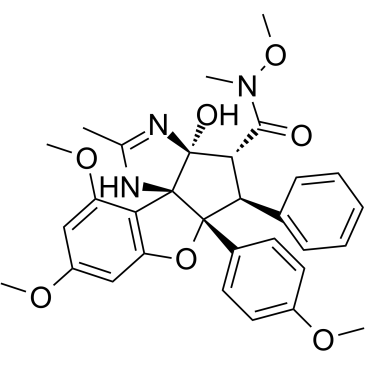2368900-35-8
| Name | CMLD012612 |
|---|
| Description | CMLD012612 is an amidino-rocaglate containing a hydroxamate group and is a potent eukaryotic initiation factor 4A (eIF4A) inhibitor. CMLD012612 inhibits cell translation and is cytotoxic to NIH/3T3 cells with an IC50 value of 2 nM. CMLD012612 inhibits eukaryotic translation initiation by modifying the behavior of the RNA helicase (eIF4A) and possesses potent anti-neoplastic activity[1]. |
|---|---|
| Related Catalog | |
| Target |
eIF4A[1] |
| In Vitro | The IC50 of CMLD012612 toward NIH/3T3 cells is 2 nM. The primary mechanism of action of CMLD012612 is dependent on eIF4A1, since eIF4A1em1jp cells are at least 10-fold more resistant than parental NIH/3T3 cells. The sensitivity of eIF4A1em1jp cells to CMLD012612 observed at higher concentrations may be due to the presence of wild-type eIF4A2 in the cells[1]. |
| In Vivo | CMLD012612 (0.5 mg/kg; intraperitoneal injection; for 3 hours; female C57BL/6 mice) treatment effectively suppresses liver polysomes 3 hours after injection, indicating inhibitory activity toward protein synthesis[1]. When administered to mice bearing myr-Akt/Em-Myc lymphomas, CMLD012612 (0.2 mg/kg; intraperitoneal injection; daily; for 5 days; female C57BL/6 mice) treatment effectively synergizes with Doxorubicin, leading to complete tumor loss[1]. Animal Model: Female C57BL/6 mice[1] Dosage: 0.5 mg/kg Administration: Intraperitoneal injection; for 3 hours Result: Effectively suppressed liver polysomes 3 hours after injection. |
| References |
| Molecular Formula | C31H33N3O7 |
|---|---|
| Molecular Weight | 559.61 |
